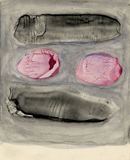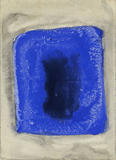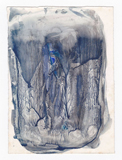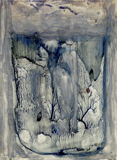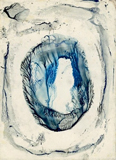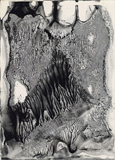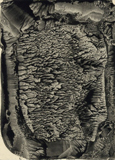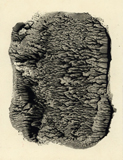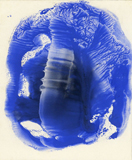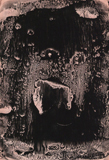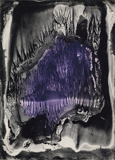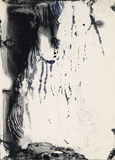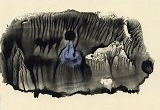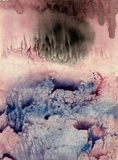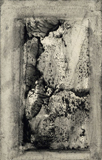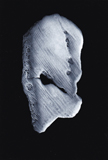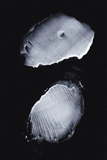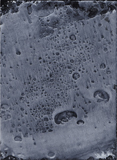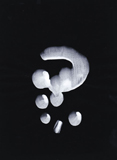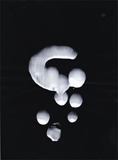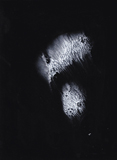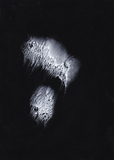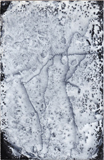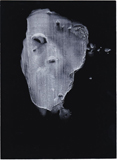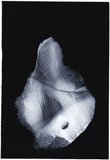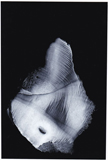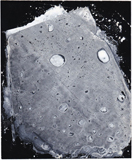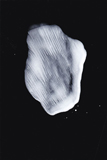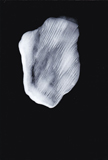Shuzo TAKIGUCHI Exhibition - IIMarch 12 Wed. - March 29 Sat. 2014 |
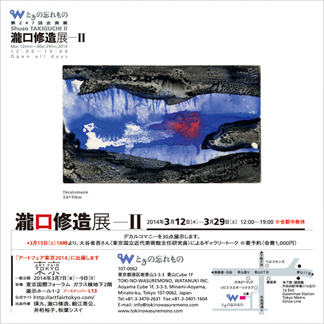 |
"II-12" Decalcomanie, paper Image size: 5.4×9.0cm Sheet size: 5.4×9.0cm |
|
Known as a poet, an art critic, and an introducer of surrealism movement, Shuzo Takiguchi was a leading figure of Japanese avant-garde art, being an emotionally supporting figure for countless young artists before and after the war. However, his activity has changed since 1958, after participating in Venice Biennale as a commissioner and later travelling across Europe, meeting people like Andre Breton and Marcel Duchamp. After returning to Japan, he begun to create himself, producing works such as a drawing, a water color, a burnt drawing, a roto-dessin and a decalcomanie. Many are small scale, but are all beautiful. These works proved Takiguchi to be regarded as a respectful sculptor and artist both in their quality and quantity.
There has been a touring exhibition of "Poet and Art -Shuzo Takiguchi's surrealism-" from May to December of 2013 in Japan, introducing Takiguchi's activity through his life from poetic experiment in his youth, critic activity during pre and post war period to his own creations after travel to Europe. In our "Shuzo TAKIGUCHI Exhibition", we focus on these works produced by Takiguchi and introduce his various techniques. Similar exhibition was "Shuzo Takiguchi : Plastic Experiments", held in July 2001 to January 2002 at the Museum of Modern Art, Toyama and the Shoto Museum of Art, Shibuya. It is an exhibition of similar kind, first time in 11 years, and this is going to be the first Shuzo Takiguchi exhibition at Toki-no-Wasuremono.
This exhibition is held in three parts. Part I in January exhibited watercolors and drawings, in part II we exhibit around 30 color decalcomanies.
Essays by Shuzo TAKIGUCHI
"First-hand Experiences"
"I also Draw (1961)"
Essay on Shuzo TAKIGUCHI
"Shuzo Takiguchi - Life and Works" by Nobuhiko Tsuchibuchi
■Shuzo TAKIGUCHI (1903.12.7 - 1979.7.1)
Known as a poet and an art critic. Embodied the principle of surrealism and supported activities of numerous artists as a logic and a moral support of an avant-garde movement during pre and post war era of Japan. He collaborated with artists in and out of Japan to create illustrated collection of poems, and also created various artworks himself.
Born 1903 in Toyama prefecture. He was intimate with literatures and arts from young age, and was especially fond of William Blake. While at Keio University Faculty of Letters Department of English Literature, he was deeply influenced by the surrealism, introduced by his teacher Junzaburo Nishiwaki, and through books such as "The Surrealist Manifesto" and "The Magnetic Fields". He published series of experimental poetic texts while at the university, and also fully translated Andre Breton's "Surrealism and Painting". Graduated in 1931, Takiguchi was employed as a scriptor at PCL (Photo Chemical Laboratory, predecessor of Toho Company, Ltd.) and started his activity as an art critic. He continued correspondenses between overseas surrealist, translated and introduced Breton's "The Communicating Vessels", "Mad Love", his lecture in the International Cultural Defence Convention of Artists against Nazi, along with works of artists such as Ernst and Dali. In 1937, Takiguchi organised "the Overseas Surrealism Exhibition" with Sansei Yamanaka (also edited the memorial publication "Album Surrealist"). Along with art criticisms such as "Surrealism sculpting theory" and "Problems on Avant-garde Art", he has also released photo criticisms such as "Photography and Surrealism" and "Materials and Photographs", guiding researching avant-garde artists and photographers who were not members of art circles. Unfortunately, this was regarded as an international communist activity, and he was captured by a special police for seven months from the spring of 1941.
After the war, he has presented many art criticisms, becoming a representative critic of the era. While providing chances for young artists by planning over 200 exhibitions at Takemiya Gallery, he also took part in the activity of "Jikken Kobou (Experiment studio)" founded in 1951 as an advisor. With his honest character, his influence was very significant.
In 1958, he traveled to Europe to take part in the Venice Biennale as a commissioner. There he rated Italian architecture representative Fonatana very highly, and voted him for the painting section. After the Biennale, he traveled across Europe to meet people such as Andre Breton, Marcel Duchamp, Salvador Dali and Henri Michaux (He recalled meeting with Breton was "the harvest of life").
After returning to Japan, his writings on art criticism were reduced, and more private writings, like an introductory note of an exhibition has increased. Contrary to retiring from public positions, he was very enthusiastic to become a special counsel for Genpei Akasegawa's "1,000 yen note incident" which was on court between 1965 to 1970. Collaborating with many artists such as Joan Miro and Sam Francis to create illustrated collection of poems, he also created many works using unique techniques such as drawing, a water color, a burnt drawing, a roto-dessin and a decalcomanie and held several solo-exhibitions with his own works. In 1967 he published "Shuzo Takiguchi's poetic Experiments 1927-1937" in which he recollected poetic texts he wrote during the war. He has also left a prose text in a form of a dream record and other proverb like short phrase works. He was offerred the name "Rrose Selavy" for his conceptual "objet shop" from Marcel Duchamp, who he kept in touch since his travel to Europe mentioned above. In return, he published "Selected words of Marcel Duchamp" in 1968. He continued his research on Duchamp, later producing multiple sculptures which multi-layerizated part of Duchamp's "Large Glass"(Rrose Selavy, Tokyo 1977. Collaborated with sculptor Kazuo Okazaki). Passed away in 1979 due to an heart attack.
<Shuzo TAKIGUCHI Exhibition - II> works list
March 12 Wed. - March 29 Sat. 2014
No. |
Image |
Title |
Date | Medium | Measurement |
1 |
Decalcomanie, watercolor, paper | Image size: 14.0×12.3cm Sheet size: 15.1×12.3cm |
|||
2 |
Decalcomanie, watercolor, paper | Image size: 13.6×9.9cm Sheet size: 13.6×9.9cm |
|||
3 |
Decalcomanie, watercolor, paper | Image size: 14.2×5.1cm Sheet size: 14.2×5.1cm |
|||
4 |
Decalcomanie, paper * In pair with "II-5" |
Image size: 13.6×9.7cm Sheet size: 13.6×9.7cm |
|||
5 |
Decalcomanie, watercolor, paper * In pair with "II-4" |
Image size: 13.6×9.9cm Sheet size: 13.6×9.9cm |
|||
| (Reverse size) | |||||
6 |
Decalcomanie, paper | Image size: 13.8×9.9cm Sheet size: 13.8×9.9cm |
|||
7 |
Decalcomanie, paper * In pair with "II-8" |
Image size: 13.7×9.9cm Sheet size: 13.7×9.9cm |
|||
8 |
Decalcomanie, paper * In pair with "II-7" |
Image size: 11.0×8.5cm Sheet size: 13.7×9.8cm |
|||
9 |
Decalcomanie, paper | Image size: 12.1×10.1cm Sheet size: 12.9×11.0cm |
|||
10 |
Decalcomanie, paper | Image size: 16.7×11.6cm Sheet size: 16.7×11.6cm |
|||
11 |
Decalcomanie, paper | Image size: 13.6×9.9cm Sheet size: 13.6×9.9cm |
|||
| (Reverse side) | |||||
12 |
Decalcomanie, paper | Image size: 5.4×9.0cm Sheet size: 5.4×9.0cm |
|||
13 |
1962 | Decalcomanie, paper * In pair with No.76 in The Museum of Modern Art,Toyama |
Image size: 7.3×12.6cm Sheet size: 9.8×13.7cm |
||
14 |
1962 | Decalcomanie, paper * In pair with No.53 in The Museum of Modern Art,Toyama |
Image size: 12.5×9.2cm Sheet size: 12.5×9.2cm |
||
15 |
Decalcomanie, paper (Postcard) | Image size: 14.1×9.0cm Sheet size: 14.1×9.0cm |
|||
16 |
Decalcomanie * Pair of No.198 from "Shuzo Takiguchi: Plastic Experiments" (2001) |
Image size: 14.2×7.3cm Sheet size: 19.3×13.1cm |
|||
17 |
Decalcomanie * Pair of No.197 from "Shuzo Takiguchi: Plastic Experiments" (2001) (Bottom image differs) |
Image size: 12.3×9.0cm Sheet size: 19.4×13.1cm |
|||
18 |
Decalcomanie | Image size: 15.7×9.0cm Sheet size: 19.3×13.1cm |
|||
19 |
Decalcomanie * Pair of No.223 from "Shuzo Takiguchi: Plastic Experiments" (2001) |
Image size: 26.3×19.0cm Sheet size: 26.3×19.0cm |
|||
20 |
Decalcomanie * In pair with "II-21" |
Image size: 14.2×9.3cm Sheet size: 25.8×19.0cm |
|||
21 |
Decalcomanie * In pair with "II-20" |
Image size: 15.5×9.3cm Sheet size: 25.7×19.0cm |
|||
22 |
Decalcomanie * In pair with "II-23" |
Image size: 15.0×10.0cm Sheet size: 26.9×20.0cm |
|||
23 |
Decalcomanie * In pair with "II-22" |
Image size: 15.5×10.5cm Sheet size: 27.0×19.3cm |
|||
24 |
Decalcomanie | Image size: 20.4×13.7cm Sheet size: 20.4×13.7cm |
|||
25 |
Decalcomanie | Image size: 18.5×14.8cm Sheet size: 26.4×19.1cm |
|||
26 |
Decalcomanie * In pair with "II-27" |
Image size: 14.0×10.0cm Sheet size: 19.2×13.2cm |
|||
27 |
Decalcomanie * In pair with "II-26" |
Image size: 13.5×10.5cm Sheet size: 18.4×12.3cm |
|||
28 |
Decalcomanie * Pair of No.222 from "Shuzo Takiguchi: Plastic Experiments" (2001) |
Image size: 13.0×10.7cm Sheet size: 13.3×11.0cm |
|||
29 |
Decalcomanie * In pair with "II-30" |
Image size: 11.2×7.3cm Sheet size: 19.4×13.2cm |
|||
30 |
Decalcomanie * In pair with "II-29" |
Image size: 11.2×7.5cm Sheet size: 19.3×13.2cm |
Gallery View
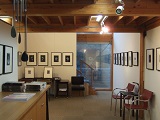 |
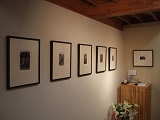 |
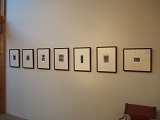 |
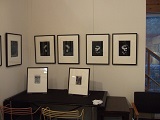 |
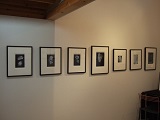 |
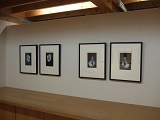 |
For price, more information and orders, please contact us via our inquiry form or e-mail us.

